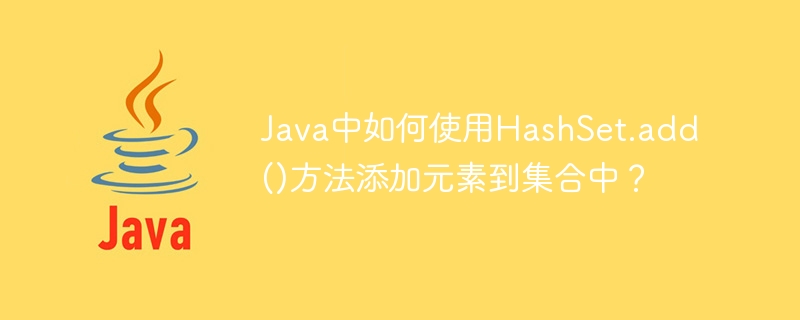How to use HashSet.add() method to add elements to a collection in Java?

It is very simple to add elements to a collection using the HashSet.add() method in Java. Let’s introduce it in detail below.
HashSet is a collection class in Java. It inherits from the AbstractSet class and implements the Set interface. The characteristics of HashSet are unordered and non-repeating, and the underlying implementation is based on a hash table.
When using the HashSet.add() method to add elements, you need to pay attention to the following points:
- HashSet can only store elements of object type, not elements of basic data types. . If you need to store elements of basic data types, you can use the corresponding packaging class to encapsulate them.
- The elements in HashSet are unordered, and when adding elements, they will not be arranged in the order they are added.
- The elements in the HashSet are not repeated. If you try to add an existing element, it will be ignored.
The following is a simple sample code that demonstrates how to use the HashSet.add() method to add elements to a collection:
import java.util.HashSet;
public class HashSetDemo {
public static void main(String[] args) {
HashSet<String> myHashSet = new HashSet<>();
// 添加元素
myHashSet.add("Apple");
myHashSet.add("Banana");
myHashSet.add("Kiwi");
myHashSet.add("Orange");
myHashSet.add("Grape");
// 输出HashSet中的元素
System.out.println("HashSet中的元素:" + myHashSet);
// 尝试添加重复元素
myHashSet.add("Apple");
// 输出HashSet中的元素
System.out.println("尝试添加重复元素后,HashSet中的元素:" + myHashSet);
}
}Run the above code, the output results are as follows:
HashSet中的元素:[Grape, Kiwi, Orange, Banana, Apple] 尝试添加重复元素后,HashSet中的元素:[Grape, Kiwi, Orange, Banana, Apple]
You can see that the elements in the HashSet are unordered and will be ignored when adding duplicate elements.
Through the above examples, I believe everyone already understands how to use the HashSet.add() method to add elements to a collection. In practical applications, different collection classes can be selected to store data according to specific needs for more efficient and convenient operations.
The above is the detailed content of How to use HashSet.add() method to add elements to a collection in Java?. For more information, please follow other related articles on the PHP Chinese website!

Hot AI Tools

Undresser.AI Undress
AI-powered app for creating realistic nude photos

AI Clothes Remover
Online AI tool for removing clothes from photos.

Undress AI Tool
Undress images for free

Clothoff.io
AI clothes remover

AI Hentai Generator
Generate AI Hentai for free.

Hot Article

Hot Tools

Notepad++7.3.1
Easy-to-use and free code editor

SublimeText3 Chinese version
Chinese version, very easy to use

Zend Studio 13.0.1
Powerful PHP integrated development environment

Dreamweaver CS6
Visual web development tools

SublimeText3 Mac version
God-level code editing software (SublimeText3)

Hot Topics
 Square Root in Java
Aug 30, 2024 pm 04:26 PM
Square Root in Java
Aug 30, 2024 pm 04:26 PM
Guide to Square Root in Java. Here we discuss how Square Root works in Java with example and its code implementation respectively.
 Perfect Number in Java
Aug 30, 2024 pm 04:28 PM
Perfect Number in Java
Aug 30, 2024 pm 04:28 PM
Guide to Perfect Number in Java. Here we discuss the Definition, How to check Perfect number in Java?, examples with code implementation.
 Random Number Generator in Java
Aug 30, 2024 pm 04:27 PM
Random Number Generator in Java
Aug 30, 2024 pm 04:27 PM
Guide to Random Number Generator in Java. Here we discuss Functions in Java with examples and two different Generators with ther examples.
 Armstrong Number in Java
Aug 30, 2024 pm 04:26 PM
Armstrong Number in Java
Aug 30, 2024 pm 04:26 PM
Guide to the Armstrong Number in Java. Here we discuss an introduction to Armstrong's number in java along with some of the code.
 Weka in Java
Aug 30, 2024 pm 04:28 PM
Weka in Java
Aug 30, 2024 pm 04:28 PM
Guide to Weka in Java. Here we discuss the Introduction, how to use weka java, the type of platform, and advantages with examples.
 Smith Number in Java
Aug 30, 2024 pm 04:28 PM
Smith Number in Java
Aug 30, 2024 pm 04:28 PM
Guide to Smith Number in Java. Here we discuss the Definition, How to check smith number in Java? example with code implementation.
 Java Spring Interview Questions
Aug 30, 2024 pm 04:29 PM
Java Spring Interview Questions
Aug 30, 2024 pm 04:29 PM
In this article, we have kept the most asked Java Spring Interview Questions with their detailed answers. So that you can crack the interview.
 Break or return from Java 8 stream forEach?
Feb 07, 2025 pm 12:09 PM
Break or return from Java 8 stream forEach?
Feb 07, 2025 pm 12:09 PM
Java 8 introduces the Stream API, providing a powerful and expressive way to process data collections. However, a common question when using Stream is: How to break or return from a forEach operation? Traditional loops allow for early interruption or return, but Stream's forEach method does not directly support this method. This article will explain the reasons and explore alternative methods for implementing premature termination in Stream processing systems. Further reading: Java Stream API improvements Understand Stream forEach The forEach method is a terminal operation that performs one operation on each element in the Stream. Its design intention is






